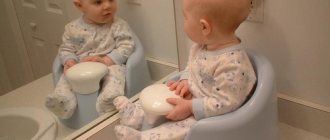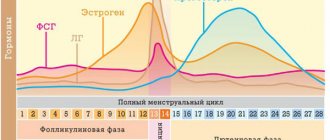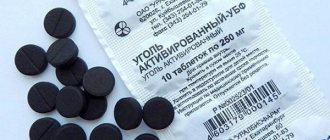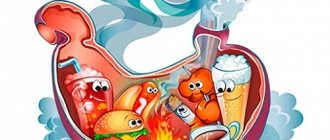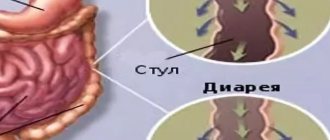Parents often complain about the presence of mucus in their child’s stool. And they are doing the right thing, because defecation is considered an indicator of the baby’s health, so the appearance and consistency of stool undoubtedly needs to be monitored. Is this symptom considered dangerous? What is the reason for its appearance and should something be done? We will discuss these questions in our article.
What does the color of mucus mean?
Mucus in stool can look different. Its shade depends on the reason that caused the deviation. Here's what the discharge colors say:
- Green. Indicates the rapid proliferation of pathogens in the intestines. A small amount of such mucus occurs during dysbiosis. Abundant inclusions may indicate enteritis or bacterial colitis. The smell of feces is particularly foul.
- Yellow. It speaks of progressive inflammation. The mucus takes on this color due to the large number of leukocytes in it. Sometimes pus impurities are responsible for the yellowish color.
- Pink. Very bad color. The mucus contains streaks of blood. This symptom may indicate Crohn's disease, erosion, or ulcers in the intestines.
- White. The mucus contains exfoliated epithelial cells. Similar processes occur when the inner lining of the intestines is irritated due to allergies. This color also occurs with worms.
- Red. Explained by a large number of blood impurities. Often, mucus of this color becomes the result of mechanical trauma to the rectum due to frequent use of enemas or gas tubes. A bloody tint may indicate Crohn's disease or allergic colitis.
- Red-brown, black mucus colors occur when internal bleeding has opened.
Infant feces - color and disease
The consistency of the mucus also matters. Thick discharge, similar to a dense “jelly” lump, is characteristic of parasite infestations. Liquid - for conditions associated with pancreatic dysfunction or lactose intolerance in a child.
If, instead of stool, only watery mucus is released, an acute intestinal infection is most likely present.
The color of the mucus indicates the nature of the process:
- Transparent slime. Most often it appears during viral inflammation, against the background of physiological causes.
- Green slime. Indicates the addition of a bacterial agent, or the passage of snot in transit through the entire gastrointestinal tract.
- White streaks of mucus. They talk about the presence of fibrin effusion and most often occur with fungal invasion (candidiasis, intestinal damage by Mycobacterium tuberculosis). Also, white streaks occur during helminthic infestation or during the healing of ulcers and erosions against the background of an autoimmune process.
- Streaks of blood. Appear when the capillary network is damaged or excessive permeability during intussusception or amoebic infection.
Normal or deviation
In the first months of life, the baby’s stomach and intestines work in test mode, and therefore require special attention. But pediatricians warn about the acceptable amount of mucus in the stool of an absolutely healthy baby up to three months of age. Let's try to figure out how to recognize the norm and not miss the pathology.
What is meconium
Newborns' first feces are called meconium. It contains epithelial cells and hairs processed in the prenatal period, as well as water, bile, mucus, amniotic fluid and bacteria. According to Spanish researchers, among them are lactobacilli and E. coli. This means that even in the womb, protective functions are formed in a small organism. Meconium is excreted from the baby's intestines during the first days of life. Its characteristic features are the absence of odor, dark color, viscous and sticky consistency.
Norms of mucus in feces
Subsequently, the child poops jelly-like or watery yellow discharge with a small amount of mucus. This is not at all a symptom of any disease and should not cause panic among parents. The baby's intestines thus protect themselves from aggressive acids and alkalis that form in the digestive organs during the processing of breast milk. However, mucous secretions mix with feces in the large intestine, so they are practically not visible at the exit. You should be wary when you often notice individual mucous fragments in children's feces. If they appear rarely, then there is no reason to panic. You need to sound the alarm when your baby's stool has an unpleasant, pungent odor and contains blood. At the same time, the baby sleeps poorly, is restless, often burps, and does not gain weight.
Possible reasons
Quite often this phenomenon is observed in children in the first days or weeks of life. Mucous stool in a newborn is explained by the fact that the baby has a sterile gastrointestinal tract. Along with food, various bacteria penetrate into it - both beneficial and pathogenic. A struggle for survival begins between them.
- violation of the diet by a nursing mother;
- unsterile breast milk;
- intestinal dysbiosis caused by pathogens;
- lactose intolerance;
- switching to another type of formula when artificial feeding;
- thrush transmitted by the mother during childbirth;
- introducing complementary foods too early.
Poor nutrition is one of the reasons for the appearance of mucus.
In older children, the most common reason for the appearance of a lump of mucus (or several) is dysbacteriosis. This is especially true if we are talking about a one-year-old baby who puts everything in his mouth and can easily catch an infection. Of course, for this reason, mucus may appear in the stool in a child of 2 years of age, as well as in older children.
Other common reasons include:
- an unbalanced diet or a sudden change in it;
- colds, acute respiratory infections, ARVI;
- taking antibiotics;
- hypothermia in the pelvic area (bathing in a pond for a long time or sitting on damp ground);
- worms;
- prolonged constipation;
- allergic reaction.
Much less common in children are such provoking factors for the appearance of lumps of mucus in the stool, such as autoimmune pathologies, cancer, Crohn's disease, intestinal obstruction, cystic fibrosis, colitis. All of these ailments are very serious. During the examination, they should be excluded first.
Normal stool in a baby
Why does mucus appear?
Each age category has its own causes of pathological stool. What is normal in an infant can be a sign of a pathological process at an older age.
Mucus in the stool of newborns up to 3 months is considered normal, provided that there are no other changes: blood or foamy stool.
At the age of 3, a child's stool becomes similar to that of an adult. Frequent stools with mucus at this age are a reason for examination. Perhaps infectious gastroenteritis or parasite infection has begun.
The presence of mucus in stool is often caused by poor diet. When consuming a large amount of dairy products or vice versa when there is a lack of protein foods. Also, during prolonged fasting, the body begins to actively produce mucus. This is not a pathology, you just need to adjust your diet.
Sometimes mucus in poop is associated with infectious and inflammatory processes in the body, such as gastrointestinal infections, intestinal obstruction, and dysbiosis. Intolerance to certain foods is also often manifested by mucous stool in a child.
When should you consult a doctor?
It is necessary to show the child to a pediatrician if the appearance of mucus is accompanied by other symptoms of various diseases, including:
- foul-smelling diarrhea;
- darkening of urine;
- rare urination;
- profuse and frequent regurgitation;
- smell from the mouth;
- heat;
- weight loss;
- loss of appetite;
- sunken fontanel;
- wrinkled and sagging skin.
If one or more of these symptoms are detected, the baby should be shown to a doctor and undergo the necessary examination to identify possible health problems.
An ambulance should be called at the first suspicion of intestinal obstruction, as well as signs of intestinal infections. If a child suddenly has a fever, vomits, has frequent and foamy stools or watery stools mixed with mucus, an examination by an infectious disease specialist is required.
Mothers need to carefully monitor their baby's bowel movements. This is especially true for young children who cannot clearly describe their symptoms.
If the child’s general well-being is normal and there are no additional complaints, you can watch the baby a little, change the nature of your diet, or, if you are breastfeeding, go on a strict diet yourself. If the baby’s stool does not change within a few days, you can routinely consult with a pediatrician and, if necessary, have a culture tested for dysbacteriosis or coprogram.
We recommend reading:
Consistency of stool in an adult: where is the norm and where is the pathology?
You should definitely consult a doctor if:
- increased body temperature;
- nausea;
- vomiting;
- the appearance of pathological impurities (blood, helminths, pieces of undigested food);
- flatulence;
- change the colors of the slime to green, white or red;
- stomach ache;
- pronounced anxiety of the baby, crying;
- severe diarrhea.
What if you have foamy stool?
Foamy feces with mucus are often observed in children at an early age. However, there are many reasons that cause such bowel movements.
- Dysbacteriosis is a pathological condition that causes diarrhea, which can consist of various inclusions. Foamy yellow stools are often observed, containing lumps of undigested food and a large amount of mucus.
- Staphylococcal infection is a disease that also causes foamy stools, but this symptom is not the main one. If a child has diarrhea with mucus, a painful stomach, or vomiting, then you should seek qualified medical help. Untimely treatment of staphylococcal infection can lead to a number of serious complications.
- Rotavirus infection - the disease is accompanied by snot, sputum, and frequent loose, foamy stools with an unpleasant, pungent odor. In the first days of illness, nausea or even vomiting may occur.
- Intestinal infections - although foamy stools are not typical for this problem, it is still possible to appear along with an increase in temperature, frequent bowel movements, and green feces. The stool may contain some blood.
The slightest signs of malaise against the background of foamy, liquid stools with inclusions of gray threads of mucous consistency should be a reason to consult a doctor.
Diagnostic methods
Abundant mucus in the stool is clearly visible to the naked eye. It is also easy to notice bloody, yellow, green, white, black masses. Before going to the doctor, it is advisable to take a closer look at the clot of mucus, determine its consistency, shade, and quantity, so that the specialist gets the most complete picture and chooses the optimal examination methods. You can take your baby's soiled diaper with you.
Stool analysis - a coprogram for diagnosing the disease
Most often, if there is mucus in the stool, a coprogram is performed. Also practiced are bacterial culture, macro- and microscopy of feces, a general blood test, studies to identify parasites, ultrasound, and x-rays. The use of certain methods depends on the symptomatic picture, medical history, age, and general condition of the patient.
It is necessary to differentiate physiological manifestations of mucus from pathological ones. The main hint about the origin of the symptom is additional clinical manifestations and a thorough questioning of the mother (what the child ate, whether he was sick with anything recently, whether new complementary foods were introduced, whether there are hereditary diseases).
Basic tests that may be needed to identify the underlying cause:
- Coprogram. Microscopic and biochemical examination of feces will determine additional pathological signs: undigested food, the presence of hidden blood, worm eggs.
- Bacteriological culture (tank culture). Allows you to determine the presence of the pathogen and its sensitivity to antibacterial therapy.
- Culture for dysbiosis. Reveals the degree of separation of pathological and beneficial microflora.
- X-ray of the abdominal organs. Allows you to determine intestinal obstruction, an important test in infants with signs of abdominal bloating against the background of continuous crying (intussusception).
- Blood tests. Even a clinical analysis will make it possible to determine the nature of the inflammation (bacterial - with neutrophilic leukocytosis, viral - with lymphocytic leukocytosis, eosinophilia - with an autoimmune process or helminthic infestations). Blood tests are also carried out to check for antibodies and increased levels of autoimmune factors.
Where does mucus come from?
In fact, mucus is an essential component of feces. It is a transparent light substance with a jelly-like consistency that is normally invisible to the human eye. Contains a mixture of leukocytes and epithelial cells.
Mucus is produced by the endothelial tissue of the small intestine to ensure normal passage of intestinal contents, thereby significantly facilitating the natural evacuation process. An equally important function also includes its protective properties, aimed at protecting the intestinal wall from irritating factors. This is why its moderate concentrations are so important for the normal functioning of the gastrointestinal tract.
After mucus enters the sections of the large intestine, it mixes with the formed intestinal contents, and therefore it becomes difficult to detect it without special studies. Visual detection is possible when mucus production exceeds normal levels. In this case, you cannot avoid contacting a pediatrician.
Associated symptoms
Famous pediatrician E.O. Komarovsky points out that slight inclusions of mucus in the stool of an infant are normal, especially before the age of one month (see also: green liquid stool in a one-month-old baby). During this period, newborns experience a deficiency of the enzyme responsible for the breakdown of milk sugar - lactase.
In some cases, mucus in the stool is a sign of a pathological process or improper nutrition of the child. Such situations are complemented by other symptoms of trouble, the main ones:
- large volumes of mucus with each bowel movement;
- increased body temperature;
- very liquid green stool with a pungent odor and streaks of blood;
- weight loss or insufficient weight gain;
- capriciousness, causeless crying.
A single case of detection of mucus when the child is feeling normal and there are no changes in his behavior is not a cause for concern. If the phenomenon repeats again and again, and other abnormalities are observed, medical attention is needed. The most common accompanying symptoms of mucus are:
- constipation and diarrhea;
- flatulence;
- lack of appetite;
- long crying;
- abdominal pain;
- fever, increased body temperature;
- cough with phlegm (which, when swallowed, enters the stomach and comes out with feces);
- profuse snot (the mechanism is the same as with sputum);
- lethargy, weakness, drowsiness;
- vomit;
- false urge to go to the toilet “for the most part.”
The combination of mucus in the stool and elevated temperature in a child is typical for any intestinal infection. But most often, such a combination is observed when pathogenic bacteria - staphylococci, streptococci, salmonella - enter the gastrointestinal tract.
The diseases also manifest themselves with the following symptoms:
- sour belching;
- heartburn;
- attacks of nausea and vomiting;
- pain in the epigastric region;
- weakness, fatigue.
High temperature leads to thickening of urine, decreased appetite and dangerous dehydration. Such symptoms are nonspecific - they accompany pancreatitis, celiac disease, and autoimmune pathologies.
Diarrhea
Watery stools with mucus are only normal for newborns. In infants, it is observed with incorrect, too early introduction of complementary foods, low fat content of mother's milk. Diarrhea with mucus also occurs due to inappropriate milk formula, consumption of fatty, unusual foods. Frequent bowel movements are defined as defecation of liquid stool more than 5 times a day. If peristalsis does not return to normal within one day, the help of a doctor is required.
But constipation is not as dangerous as diarrhea. The discharge of abundant mucus from the anus indicates good functioning of the goblet cells. They “try” to facilitate the passage of hard feces, as if lubricating the intestinal walls. But the cause of constipation must be identified and eliminated, otherwise putrefactive processes will occur.
Intestinal infections
A characteristic symptom of acute gastroenteritis is diarrhea. It is often accompanied by vomiting, high fever, and deterioration in general condition. Watery stools may contain mucus.
As a result of the development of pathogenic microflora, the mucous membrane becomes inflamed. The intestines try to protect themselves from pathogenic microorganisms by producing large amounts of secretion.
A child pooping mucus is a process of the immune system fighting an intestinal infection.
With an intestinal infection, the baby experiences a high temperature and mucus in the stool. The color of stool depends on the type of pathogen.
Yellow mucus in a child’s stool indicates the development of a bacterial process. Transparent occurs with physiological enterocolitis.
If infectious gastroenteritis is suspected, it is not recommended to feed the child dairy products.
When an infection enters the digestive tract, the production of the enzyme that breaks down milk sugar is reduced. And the accumulation of milk sugar in the intestines causes even more dilution of the stool.
Actions to take if mucus is detected in stool
If mucus is detected in the stool, you should definitely consult a specialist. If the symptom is isolated and disappears after normalization of nutrition, then it was most likely a reaction to a violation in the diet.
Timely administration of correct treatment significantly reduces the risk of complications and speeds up the recovery process. One should take into account the fact that young patients cannot always adequately assess their condition or describe their sensations, which greatly complicates diagnosis.
Even if the parents have a medical education, they cannot diagnose the cause of mucus in the stool at home. When mucus in the stool occurs against the background of the child’s well-being, in the absence of other symptoms of the disease, you need to observe the baby for 2-3 days. If nothing changes, then medical intervention is necessary. You should not experiment with the diet - perhaps the little patient needs urgent treatment.
The famous pediatrician Komarovsky always urges parents not to panic. Even if the cause of mucus in a child’s stool is a disease, it is almost always possible to cure it.
Komarovsky's recommendations:
- during breastfeeding, the mother should refuse heavy fatty foods;
- You need to choose complementary foods according to the age of the child;
- Children's diets should include fruits and vegetables with coarse fiber.
But the best preventive measure is regular medical examinations. After all, a disease detected at an early stage is always treatable.
Having noticed unusual inclusions in the feces of their child, the first thing parents should do is to carefully look at his behavior: is he sleeping well, is he crying for no reason, is he behaving as usual or has something changed, has he lost his appetite... If everything is normal, and more mucus appeared, but there was no diarrhea, vomiting, or fever, you could exhale. Most likely, there was some kind of temporary glitch ⏱️.
In the same case, when there are accompanying symptoms and the stool contains characteristic impurities, you should not hesitate to visit a doctor. Without a diagnosis, there is no point in carrying out any treatment.
Generally accepted norm
Mucus in the stool of a baby.
Komarovsky advises Changing the stool of babies begins from their very birth. First, meconium must come out, and then potassium masses acquire other indicators related to the type of food (breast milk or formula).
With the introduction of complementary foods, the consistency, color and smell change again. While the baby is getting used to the new food, says Evgeny Komarovsky, the baby may have remnants of undigested food, mucus, bloody streaks, etc. in the feces. It is also important to monitor the child’s condition. If he is active, has a good appetite, sleeps soundly, feels great - a change in stool does not mean any illness. Their main reason is considered to be the adaptation of the digestive system to a new product . See your pediatrician to calm your nerves, and continue to grow up healthy.
What is normal stool in children under one year of age? Each baby has its own norm, the main thing here is comprehensive monitoring of him and his stool.
General characteristics of the physiological norm:
Color:
- all shades of yellow;
- orange;
- light brown;
- green (light, dark), if breast milk and complementary foods predominate in the diet;
- different color due to taking medications, vitamins (which one - check with the doctor who prescribed them).
Consistency:
- mushy;
- heterogeneous;
- soft, maybe liquid.
General characteristics of the physiological norm of feces in infants
Impurities:
- multiple curd lumps (white) - indicates overeating when digestion does not have time to process the amount of breast milk (formula);
- mucus in the stool of a baby - Komarovsky E.O. recommends paying attention to its volume, frequency, and general condition of the child (all children have it, and this is normal).
See a doctor immediately if your child has black stool. It is considered normal only due to the use of certain medications, for example, activated carbon. If the feces include black fragments, or are completely colored for no apparent reason, this is a sign of serious upper gastrointestinal bleeding .
Discolored (white) potassium masses are also not normal, but a sign of hepatitis .
Mucus due to diarrhea
Mucus accompanied by diarrhea is the main sign of dysbiosis. It is almost transparent if the disorder is caused by antibiotics. With “killed” intestinal microflora, digestion is seriously impaired. A child may ask to use the potty or toilet literally ten minutes after eating. His body receives very few nutrients. Diarrhea with mucus is usually accompanied by abdominal pain and increased gas formation.
Frequent loose stools in infants are a special cause for concern.
The small, immature organism becomes dehydrated very quickly, which can be fatal. The situation gets worse when diarrhea is accompanied by vomiting. The baby must be urgently taken to the hospital or an ambulance called.
A doctor's examination is mandatory for infants.
Lactase deficiency
Lactose intolerance (milk sugar) occurs due to a lack of the necessary enzyme lactase in the body.
With its deficiency, lactose, entering the large intestine undigested, attracts water, which leads to diluted stool. Under the influence of bacteria, the fermentation process begins, resulting in the formation of foam and mucus in the stool.
Pathological manifestations occur a few minutes after consuming a dairy product. Acute diarrhea is observed, which is characterized by wateriness and an unpleasant sour odor, abdominal pain, a large amount of gas in the intestines, and loss of appetite.
When a child drinks milk, he can clearly hear rumbling in his stomach. Often such children cry during feeding. Infants with lactase deficiency do not gain weight well, are restless, and suffer from frequent colic.
Most often develops at the age of 3-6 months. To confirm the diagnosis, it is necessary to undergo a lactose stress test and submit stool for coprogram. In the stool analysis of infants older than 2 months, carbohydrates and a reduced Ph are detected.
Lactase deficiency is characterized by bright yellow stool with mucus and a sour odor.
Normal stool in a child undergoing breastfeeding
A newborn's stool can take on different colors and consistency - this depends on the diet of the breastfeeding mother and complementary foods. Correct organization has an impact on the child's stool - feeding at the same time so as to prevent overeating and long periods of fasting.
Mucus in a newborn's stool is normal. What are considered normal bowel movements in infants:
- the first three days of life - black or dark green stool with the consistency of thick sour cream, odorless;
- from 3 to 14 days – up to 10 bowel movements per day, gray-green or dark gray stool;
- 14 – 30 days – bowel movements after each meal, the frequency is gradually reduced to 2-3 times a day, the stool is brown or yellow.
White grains, green mucous impurities in a small volume, a faint smell, like cottage cheese or kefir - these are normal phenomena for a child’s stool in the first 10-12 months.
Breast-feeding
In the first month, the newborn's stools are light yellow after each feeding.
It is important to follow the rules of breastfeeding; the baby needs to receive more hind milk than fore milk. Hindmilk contains an enzyme necessary to digest food.
Mucus in the stool of a month-old baby often occurs due to a lack of this enzyme. Therefore, the mother should monitor that the baby sucks the breast completely.
Intestinal microflora is established up to 3-6 months, so in a three-month-old baby the color of stool may be greenish, mixed with mucus. With age, digestion normalizes.
If a breastfed child under one year old often has mucus on the surface of the stool, the nursing mother needs to have her milk tested for sterility or change her diet.
Mucus due to constipation
☝️ Mucus is often a phenomenon with constipation. A large amount of it is secreted to protect the walls of the colon, which can be easily injured by hardened fecal stones. The mucous masses are usually white. Sometimes they have a pinkish or light red tint, which may indicate the presence of mechanical damage.
Mucus due to constipation is a symptom of many dysfunctions. It is more common in adults (with hemorrhoids, neoplasms, intestinal obstruction), but sometimes pediatric doctors also record it.
Constipation in a child is almost always accompanied by mucus
Possible diseases
The pathological presence of mucus in the stool of an infant can occur for a number of reasons associated with diseases of the gastrointestinal tract of any etiology. The main diseases with increased mucus production include:
- Dysbacteriosis and changes in microflora. A common situation when the intestines are damaged by staphylococci, enterobacteria, clodistria and other pathogenic agents. In addition to mucus, parents note constipation, flatulence, and increased colic. In severe cases of the disease, curdled milk particles and streaks of blood may be present in the stool.
- Acute intestinal infections. Damage to the intestines by pathogenic microflora is often severe and occurs as a result of dysentery, toxic infections, intestinal flu and salmonellosis. The progression of the clinical picture in these diseases is always rapid; the diseases can be life-threatening for the baby. Frequent vomiting and diarrhea can cause severe dehydration and death of the baby. Treatment of acute abdomen in young children requires mandatory hospitalization.
- Drug treatment. Another reason for the appearance of mucus can be anti-colic drugs, for example, Bebicalm, Bobotik, Espumisan. Defoamers promote intense mucus secretion in young children.
- Introduction of complementary foods, mixtures. Usually, a violation of the usual diet, especially if it is introduced incorrectly, can provoke not only a change in the structure of the stool, but also its color and consistency.
- Lactase deficiency. Lactase is an enzyme that ferments breast milk. Congenital lactase deficiency leads to fermentation failure in the form of strong gases, pain, loose stools and other signs of dyspeptic disorders. Diagnostic measures include diagnosing stool for carbohydrate-containing enzymes.
- Gluten deficiency. The pathology is called celiac disease when secondary signs of lactase deficiency appear. Timely diagnosis and adequate therapy allow you to quickly cope with the disease, eliminate its symptoms and prevent complications.
- Intestinal invaginitis. A dangerous disease that requires rapid hospitalization. The pathology is characterized by partial intestinal obstruction, when one half of the intestine presses on the other. The child experiences severe pain during and after meals, vomiting often occurs, and loose stools mixed with blood or lumps of mucous fragments occur. Pathology is a surgical situation when the doctor needs to quickly spread the intussusception with a barium enema, otherwise the child may die from painful shock, sepsis or dehydration.
Important! A nonspecific cause of the appearance of mucus in the stool can be allergic reactions to various irritants in the form of weeping ulcers, peeling in the head or cheeks. Diaper dermatitis can also provoke an excess of mucous inclusions in stool.
Other factors
Specific harmless causes of feces with mucus in a child may include teething, allergic reactions, coughs and colds. In rare cases, the causes of pathological secretion of mucus in the intestines may be:
- Diverticulitis. The disease is characterized by the formation of cavities on the intestinal walls, which are filled with mucous fragments. Given the localization of mucous cavities, active pathogenic microflora and abscessive syndrome often develop there. In addition to mucus, there are also auxiliary symptoms (severe pain in the lower left part of the peritoneum, loose, frequent stools, gas formation).
- Muscoviscidosis. The etiology of the disease is genetically determined and occurs during intrauterine development as a result of gene disorders. In addition to mucus in the stool, the child has increased salivation, increased secretion of sweat glands, cough with large amounts of sputum, and frequent respiratory diseases due to sputum infection.
Mucus also occurs if a small patient has had surgery to remove most of the small intestine. The condition provokes the formation of mucous diarrhea, is long-lasting, and often occurs in young children.
Parents need to learn to independently assess the condition of the child and his stool. If mucous stool is accompanied by poor health of the baby, lack of appetite, severe cough and fever, then this may characterize a complex pathological situation. You cannot try to cure a small child on your own with decoctions and infusions of medicinal herbs or any medications for adults. It is recommended to call an ambulance quickly, as the risk of dehydration and life-threatening conditions is high. The first complementary feeding or other dietary changes are best done after consultation with a pediatrician.
Stool with mucus is always the body’s reaction to any irritants. This condition may resolve on its own within a few days. If mucous secretions persist along with feces or their secretion increases over time, a stool test should be taken, as well as a high-quality diagnosis.
ozhivote.ru
Causes of mucus in baby's stool
Mucus appears in a baby's stool for various reasons - from pathological to banal, related to the peculiarities of the child's stomach and intestines. When breastfeeding, a lot depends on what the mother eats and how the child endured childbirth - his condition in the first year of life forms the immune response, and therefore the functioning of the whole organism.
What does the amount and color of mucus indicate:
- during inflammatory processes, the volume of mucus will increase with each bowel movement;
- clear mucus – enteroviruses or inflammation of the ENT organs;
- yellow, green – bacterial infections;
- pink – may indicate blood in the stool;
- white - helminthic infestations, intestinal infections, with constipation indicates organic intestinal pathologies, polyps.
You can determine the first signs of pathological processes associated with the appearance of mucus yourself. But if the condition worsens, you need to contact a pediatrician, who will accurately determine the cause and prescribe how to cure the pathology in an infant.
Dysbacteriosis
If a baby poops mucus, the reason may lie in a violation of the intestinal microflora. This means that the concentration of beneficial bacteria in the gastrointestinal tract has decreased or some of them have been replaced by pathogenic microorganisms. A decrease in the number of beneficial bacteria is accompanied by the following symptoms:
- inclusions of undigested milk in the stool;
- curdled milk inclusions;
- foamy stools, white mucus;
- bloating, upon palpation the child reacts sharply;
- flatulence;
- increased frequency of bowel movements.
The formation of healthy intestinal microflora in a child is a long-term process that also depends on the immune system, since microflora is part of the immune system. At this age, intestinal dysbiosis can be caused by foods that are still difficult to digest; complementary feeding needs to be reconsidered. Another reason is taking medications; antibiotics often give the same reaction.
Intestinal infections
Green, dark and foul-smelling mucus in a baby’s stool also appears against the background of infection with bacteria, microbes, viruses, and fungi. Infants may suffer from the following intestinal infections:
- dysentery;
- intestinal amoeba;
- salmonella;
- rotavirus infection.
Infants are difficult to tolerate such infections. The mucus is mixed with clots, the body temperature rises, the child refuses to eat, and vomiting appears. An intestinal infection requires emergency treatment - diarrhea and vomiting quickly dehydrate the body.
Intestinal invaginitis
This is one of the most dangerous pathologies for infants. If you suspect invaginitis, you should urgently seek help. Symptoms:
- severe pain after eating - the child screams, reacts sharply to palpating the abdomen in the lower part;
- non-stop vomiting;
- the stool is liquid with admixtures of blood and mucus, gradually only mucus remains, without feces.
Reaction to complementary foods
Liquid stool with mucus may appear in an infant for the following reasons:
- starting complementary feeding earlier than six months;
- feeding vegetable purees;
- sudden transition to complementary feeding;
- too long periods of fasting;
- lack of water, liquid food.
In such cases, not only mucus appears, but the color of the stool also changes. Infants often develop green diarrhea with mucus when feeding them vegetable purees - they provoke fermentation in the still fragile intestines.
Lactase is an enzyme responsible for the decomposition of milk sugar, lactose. Its deficiency leads to foamy stools, flatulence, diarrhea, and the appearance of lumps of milk in the stool. In newborns, the absence of lactase can be congenital or appears against the background of dysbacteriosis and is temporary. Mucus lumps with milk inclusions require a test for carbohydrate content in the stool.
With gluten deficiency, a lot of mucus appears in the stool, vomiting, and nausea. The pathology is similar to lactase deficiency, but in addition to it, there is also a lack of other enzymes that break down plant proteins and cereals.
Allergy
One of the most common causes of mucus in stool. It is also accompanied by redness of the skin, rashes, peeling, and the formation of a crust on the skin of the cheeks and scalp. To eliminate the reaction, you need to identify the intolerable product, carefully review complementary feeding and the mother’s diet for the presence of allergens.
Cold
The appearance of mucus also causes a runny nose. Since a small child cannot yet clean his nose on his own, he reflexively swallows the resulting mucus, which then passes into the gastrointestinal tract. If the concentration of leukocytes in the feces of an infant exceeds the level of a cold, a pediatrician or pediatric infectious disease specialist selects treatment.
Diseases that lead to the appearance of mucus
But it is not always possible to normalize stool with mucus in an infant by simply revising the diet and diet. In some cases, medication and even surgical intervention are needed. One of the most dangerous conditions is intestinal obstruction. It happens when a section of the intestine is compressed. The baby's stomach hurts a lot and he poops pinkish mucus. You cannot hesitate in such situations; urgent hospitalization is needed.
Another serious reason why mucus appears in a child’s stool is infectious diseases. They can be very different, from salmonellosis to rotavirus infection. They are often accompanied by the following symptoms: green mucus and stool, fever, vomiting. A doctor's examination is required. Depending on the intensity of the disease, he will decide whether home treatment is sufficient or hospitalization is necessary. Dehydration, which often occurs as a result of such diseases, is especially dangerous for children in the first years of life.
Dysbacteriosis leads to the fact that the intestines do not work quite correctly. This means that mucus may appear in the stool. In the first months, a child’s microflora is just being established. This is a normal process, so a small amount of mucus should not be a cause for concern. If there is a lot of it, the stool is green, and there are also streaks of blood in it, then it is quite possible that the body cannot cope on its own.
This situation may also be a signal of lactose or gluten deficiency. The digestive system does not produce certain enzymes, as a result, the baby cannot digest milk and foods that contain gluten. This is where mucous stool appears.
Parents should know why mucus may be noticeable in stool. You cannot ignore the problem in order not to miss a serious disease. It is especially dangerous if there is a lot of mucus or it is green.
Childhood illnesses are a constant source of concern for parents, even if they are mild. The first symptoms cause alarm, and if mucus appears in the baby’s stool, parents simply panic. In this regard, it is useful to have information about the common causes of its occurrence.
Treatment with medications
☝️ Mucus in the stool is not a disease, but one of the symptoms of some kind of deviation. It is not the effect that needs to be treated, but the cause. Drug therapy for different pathologies will differ. Eg:
- If a child has a cold, has caught an acute respiratory viral infection, bronchitis, or pneumonia, antiviral medications, nasal drops, gargles, and rubbing are prescribed.
- Dysbacteriosis is treated with intestinal antiseptics and probiotics.
- For infectious intestinal diseases, antibiotics and rehydration agents are indicated. Antiviral drugs may be prescribed.
- Thrush requires the use of antifungal drugs.
- Inflammatory bowel pathologies are treated with sulfalazines and glucocortiroids.
- Pancreatitis is fought with the help of enzyme-containing drugs.
- In the presence of erosions and ulcers, healing, relieving swelling, and painkillers are indicated.
Each case is individual. It is impossible to talk about a single tactic for combating mucus. Only a doctor selects therapy.
How to get rid of mucous stool
If dysbiosis is detected, the child is treated in the form of sanitation of the tract with bacteriophages, Enterofuril or Stop Diar. To improve intestinal microflora, a monthly course is prescribed to take one of the following drugs:
- Linux;
- Hilak Forte;
- Bifiform Baby;
- Primadophilus;
- Normoflorin.
In case of lactase deficiency, therapy is directed towards changing the diet. In case of insufficient drinking regime and poor nutrition, the condition of the tract is improved by organizing proper nutrition and increasing the volume of fluid consumed. The child is given boiled water and natural juices, and the intervals between feedings are reduced.
- Monitor your baby's diet and do not allow him to eat dirty, raw or low-quality foods. Due to the entry of pathogenic strains into the intestines, the stool will become mucous and liquid, and the body temperature will rise. These signs indicate food poisoning.
- Sometimes mucus is released in feces in response to anti-bloating medications and herbal teas that the child drinks for flatulence. After discontinuation of the medication, the nature of bowel movements should return to normal. Persistence of mucus requires medical advice.
- To stabilize stool, eliminate from the child's diet all foods that affect the consistency of stool. Fast food, chips, nuts, chocolate and its derivatives, smoked foods, spicy and salty foods, soda make intestinal function difficult and create the preconditions for copious mucus secretion.
Prevention of intestinal diseases is the intake of probiotics and prebiotics during and after antibiotic therapy, high-quality food processing and timely control of helminthic infestations, as well as any measures aimed at strengthening general immunity. Whether the baby will be healthy depends on the level of care of the people close to him.
Mucus is always present in stool. It is secreted by the endothelium of the small intestine for a protective purpose. Normally, the amount of mucus entering the stool is insignificant. It is impossible to notice her.
If inclusions are visible to the naked eye, we can talk about serious health problems.
A child's feces with mucus should alert parents. There are many reasons for this phenomenon, and they all require attention. Read about the provoking factors for the appearance of mucus, possible accompanying symptoms, methods of diagnosis and treatment of diseases that caused the deviation.
Consultation with a pediatrician is required if there is mucus in the stool
When to sound the alarm
One-time diarrhea with mucus in a baby should not worry parents too much. But if such symptoms develop, you need to seek emergency help:
- diarrhea with mucus and blood;
- black and bloody impurities;
- nausea, vomiting;
- screaming, crying, constant worry;
- refusal to eat;
- acute reaction to touching the stomach;
- temperature;
- paleness or severe redness of the skin.
Diarrhea with blood and foul odor requires urgent help. Before the ambulance arrives, you should not give any medications. But it is necessary to ensure the restoration of water balance, to give more fluid, even if this ends in vomiting.
Predisposing factors
Stool containing mucus may occur in newborn babies. A healthy baby has a completely sterile stomach and intestines. From the beginning of the first feeding, the stomach is populated by microflora with a certain biocenosis. Lacto- and bifidobacteria constantly come into conflict with opportunistic and pathogenic bacteria. During the first few weeks, mucus in the stool may even be present in excess, which is normal for a child’s transitional stool.
If, due to mucus appearing in children of any age, their general well-being suffers, the child becomes lethargic or, on the contrary, agitated, then you should consult a doctor and undergo the necessary tests.
Home and folk treatment
Even the famous doctor Komarovsky, who often criticizes alarmist parents who stuff their children with medications with or without reason, believes that it is impossible to try to eliminate the regular appearance of mucus in the feces on your own. It's useless and too risky. Home treatment is possible, but only after visiting a doctor and making a diagnosis.
It consists of following a diet (excluding fatty, sweet, smoked, spicy foods), performing light physical exercises, massages (for constipation), and split meals. If an artificial baby gets sick and the reason is lactose deficiency, it will be enough to replace the regular formula with a special one.
Cumin infusion helps with constipation.
Alternative treatment for children is also exclusively supportive in nature. Depends on the characteristics of the disease.
- For dysbiosis, decoctions are prepared from chamomile, onions, cinquefoil, and oak bark.
- Colds and flu are treated with herbal teas, a runny nose is eliminated with hemlock tincture, coughs are “afraid” of black radish with honey, egg mixture, and plants that have an expectorant effect.
- Worms are removed with garlic, carrot juice and honey.
- Constipation is eliminated with juices (cabbage, orange, peach), infusion of caraway fruits, dill seeds and chamomile flowers.
Having found out why the mucus appeared, you should immediately begin to fight the cause. In this case, amateur activities are not allowed. Treatment should be prescribed and supervised by a professional doctor.
What to do
When a child poops with diarrhea, regardless of its color, it is important to eliminate the cause of the pathology. First of all, you need to rinse your stomach with chamomile decoction and take some kind of adsorbent. Most often, solutions of “Regidron” or “Oralit” are prepared. Such powders should always be in your home pharmacy. It is also important to review your diet while breastfeeding and the components of baby food. The daily menu should not contain heavy, difficult to digest food or allergy-causing foods.
Be sure to exclude carbonated drinks, sweets, smoked foods, fatty, salty, spicy, dairy and fiber-rich foods from the list of permitted foods. Preference should be given to crackers, herbal teas, rice water, bananas and boiled potatoes. They can also be given to older children. During this period, drinking plenty of fluids is very important for him. It is best to give dill water and chamomile tea.
If the baby has a fever, he needs to be given an antipyretic drug (Panadol). When symptoms of body poisoning appear, it is important to help the small body cope with toxins. To remove them, it is recommended to give the baby Enterosgel. Having noticed that the child is suffering from painful convulsive attacks in the intestinal area, you can alleviate his condition with “No-shpa”. Other medications should not be given to a child without consulting a pediatrician, because illiterate treatment can only worsen the disease. If there is no relief, immediately call an ambulance and conduct a comprehensive examination of the baby.
More about this
Nutrition of a nursing mother and baby bowel movements
The most varied stool consistency, color and impurities are found in breastfed babies. After all, as you know, the composition of breast milk and its digestion by the child’s body depend on the nutrition of a nursing mother. If the stool of a breastfed baby contains mucus, this most likely indicates that the nursing mother is not eating properly. She should give up fried, spicy, fatty and smoked foods, and reduce the amount of sweets in her diet.
Enzyme deficiency and gastrointestinal immaturity
Do not forget that an infant’s intestinal enzymes are not sufficient to digest food, unlike an adult’s body, and, therefore, mucus in a child’s stool can be caused by this reason. There is no need to worry, this is a physiological phenomenon. This means that you should be more careful when introducing complementary foods and monitor the baby’s condition and his reactions to each specific product.
If the situation gets worse, it may be worth holding off on introducing certain foods or complementary foods in general.
Dysbacteriosis
With dysbiosis in children, as a rule, there is always clear, but not white mucus, and there is quite a lot of it, while the stool is loose and frequent. This phenomenon can also be a variant of the norm for the first few months of a baby’s life, but if the stool does not normalize as it grows older, then a violation of the intestinal microflora requires appropriate correction.
Symptoms of inflammation
If parents notice white mucus in their baby's diaper, they should immediately consult their doctor.


